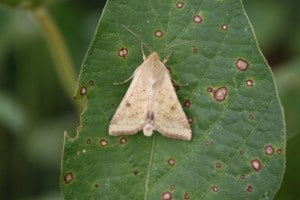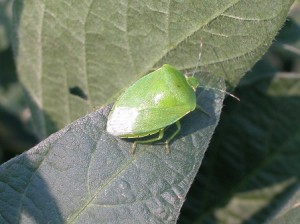
Cotton – Although plant bug populations remain lighter that usual, we are now seeing treatment levels in many fields. It’s time to switch to the drop cloth for best results. The treatment threshold for tarnished plant bug beginning at first flower is 3 tarnished plant bugs per drop cloth. You should maintain this threshold until about NAWF5+250 DD60s, at which time I suggest you relax this threshold to 5 bugs/drop cloth sample until NAWF5+350 DD60s. Clouded plant bugs are also in the mix, and I suggest counting them as equivalent to 1.5 tarnished plant bugs when making a treatment decision (because they are more damaging to bolls).
Stink bug populations also appear lower than usual, but be forewarned that when we are not spraying as much for plant bugs, stink bugs tend to take advantage. Treatment should be made when there is an average 1 stink bug per drop cloth or when 20% of thumb-sized bolls show internal evidence of feeding (staining or warts on the inside of boll walls). When dealing with a mix of plant bugs and stink bugs, I often suggest counting stink bugs as equivalent to 3 tarnished plant bugs when doing drop cloth samples.
There are reports of some bollworm moths and a few eggs being seen, and you should expect moth catches to trend upward for the next several weeks. Based on my observations in corn, I am anticipating a bigger bollworm flight this year than last, but I also expect the peak moth flight will not occur until at least the first week of August. Scouting all Bt technologies is needed. Except in rare cases, I would only expect insecticide applications for bollworm to be needed on the 2-gene technologies (e.g., Bollgard II). I’ll hit on more specifics next week, but you can refer a news article from last year if you want to get a head start.
Read more about these pests at https://guide.utcrops.com/cotton/cotton-insect-guide/, and refer to last week’s news article for treatment suggestions for plant bugs and stink bugs.

Soybean – Stink bugs are the most consistent pest of soybean in Tennessee, and although populations are generally low, you should scout the earliest maturing fields until at least R6 and use a treatment threshold of 9 stink bugs per 25 sweeps. Population often build rapidly after fields reach R5.
Kudzu bugs are just now showing up in some fields, but populations appear to be low this year. The late freeze knocked back the kudzu and the bugs at the same time. These insects will tend to infest fields during early bloom. Treatment is generally based on the number of immatures found in sweep net samples, with a threshold of 1 nymph per sweep (25/25 sweeps).
Finally, it’s not too early to keep an eye out for bollworm (corn earworm) in soybean, even though this is typically an August problem. Be especially alert in the latest maturing fields and in the river bottoms. Corn earworms are most attracted to soybean during peak flower, and especially in fields where the canopy has not closed. You can read more about managing soybean insect pests at https://guide.utcrops.com/soybean/soybean-insect-guide/.

